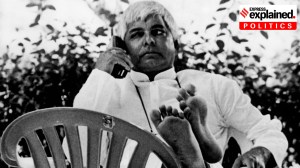Infra industries growth slows to 5.2%
Factory growth in India has dipped in May but price pressures persist.
Growth of infrastructure industries,which have a significant bearing on overall factory output,slowed to 5.2 per cent in April,with high inflation likely to have impacted the core sectors.
The six core industries,with a weight of 26.68 per cent in the country’s index for industrial production,had expanded by 7.5 per cent in the corresponding month of the previous fiscal.
The data signals moderation in overall economic growth,as measured in the Gross Domestic Product. The GDP for the fourth quarter of fiscal 2010-11 had grown by 7.8 per cent,the slowest pace in five quarters.
Headline inflation,which remains above 8 per cent,is considered to be the main dampener.
A decline in cement output and lower growth in finished steel production led to the slowdown in the pace of expansion of the infrastructure sectors,which also include crude oil,petroleum refinery products,coal and electricity.
According to provisional data released today,production of cement declined by 1.1 per cent in April this year,as against a growth of 8.8 per cent in the same month of 2010.
Cement production has declined after three months of good growth since January this year.
Growth in finished steel production slowed down to 4.3 per cent during the month under review,compared to 12.9 per cent expansion in April last year. The latest numbers mark the lowest growth in production of finished steel since July,2010.
Experts said the slowdown was expected,as high interest rates hit the industry. As the inflationary pressure continues,the trend will not change for another five-six months,they said.
Industrial production,as measured by the IIP,stood at 7.3 per cent in March,compared to 15.5 per cent expansion in the same month of 2010.
The slowdown in infrastructure sector growth could be a pointer for moderation in the overall factory output expansion.
“There is a slowdown in investments and this has been reflected in the performance of the core industries. Besides,the latest GDP data has proved that the economy has entered a period of moderate growth and it is likely to remain so for 5-6 months,” Standard Chartered head of research Samiran Chakraborty said.
He,however,said the base also has a role to play in the low numbers.
“The growth was very strong in April,2010,and this has also got reflected,” Chakraborty said.
As per the latest data,electricity output grew by just 6.8 per cent in April this year,as against 6.9 per cent in the same month of 2010.
However,the other three sectors reported better growth during the month.
Crude oil production topped the table with growth of 11 per cent in April,compared to 5.1 per cent expansion in the corresponding year-ago period.
Petroleum refinery products registered a growth of 6.6 per cent in April,as against an increase of 5.3 per cent in the same month last year. Output of these products had gone into a decline toward the last half of 2010,before recovering from December.
Coal output registered a growth of 2.9 per cent in April,2011,a complete turnaround in comparison to the same month last year,when output had contracted by 2.9 per cent.
Six core industries’ growth slows to 5.2%: Reuters
Growth in India’s manufacturing sector has eased slightly in the month of May as the pace of new orders slowed,but factories’ input and output prices continued to rise sharply,reinforcing expectations of further policy tightening by the Reserve Bank.
The HSBC Markit Purchasing Managers’ Index,based on a survey of around 500 companies,edged down to 57.5 in May from 58.0 in April,weighed down by a slower expansion rate for new orders and a labour shortage.
Even so,the level of activity in India’s manufacturing sector maintained its strong momentum and the index has now stayed above the 50 that divides growth from contraction for the 26th consecutive month. Backlogs of work also continued to increase,though capacity pressures are leading to longer delivery times.
The new orders sub-index slipped in May to 62.4 and while still signalling ongoing improvements in general economic conditions,it was weaker than the 63.1 reported in April.
“The momentum in the manufacturing sector eased in May as sequential growth in output and orders slowed a bit. However,the momentum remains strong,” said Leif Eskesen,chief economist for India & ASEAN at HSBC.
While strength in the manufacturing sector augurs well for the economy,the survey also showed the output prices sub-index picked up speed in May while input prices remained elevated.
Expectations of further tightening by the Reserve Bank of India have strengthened after the central bank increased its benchmark repo rate by 50 basis points in May in a bid to tackle stubbornly high inflation,even if the trade-off was a slowing in economic growth.
India’s economy grew 7.8 percent in January-March from a year earlier,its slowest annual pace in five quarters as rising interest rates took a toll on consumption and investment,data release on Tuesday showed.
Notwithstanding more moderate growth,the RBI is expected to raise rates by another 75 basis points this year,taking the repo rate to 8.0 percent by December,a level last seen in the latter half of 2008.
“The sequential growth rate of input costs decelerated again,but the readings are still elevated by historical standards. Moreover,output costs edged up faster. The numbers confirm that growth is holding up well and that inflation pressures are still firmly in place,which leaves the door open for continued monetary tightening,” Eskesen added.
The employment sub-index contracted the most in May since January 2009 when,at the height of the global financial crisis,firms slashed jobs to remain profitable. Survey compiler Markit said firms reported shortages of suitable labour to fill vacancies last month.
Similar manufacturing reports from China and South Korea on Wednesday also showed slowing growth,with recent data also pointing to economic sluggishness in Europe and the United States.



- 01
- 02
- 03
- 04
- 05



























